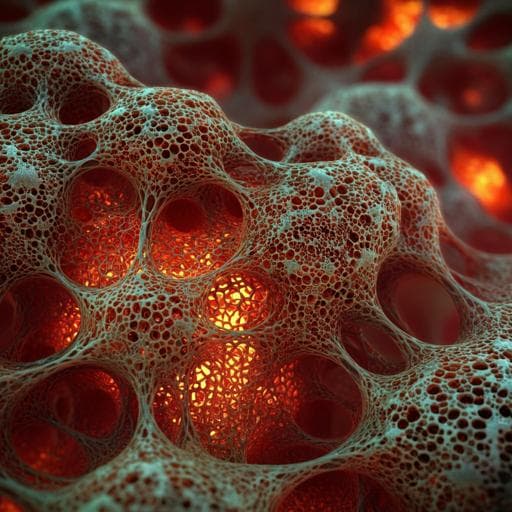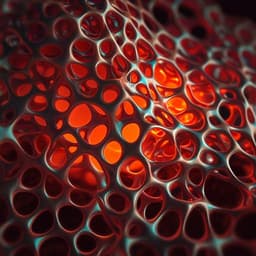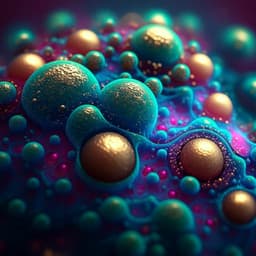
Medicine and Health
Mega-oss and Mega-TCP versus Bio-Oss granules fixed by alginate gel for bone regeneration
T. Wang, S. Xu, et al.
Explore the exciting findings of Tong-Yue Wang, Shu-Lan Xu, Zhi-Ping Wang, and Jin-Yuan Guo, who evaluated innovative bone substitutes Mega-oss and Mega-TCP against Bio-Oss. Their research reveals superior cell spreading and promising viability, suggesting that these new materials could be viable alternatives in the world of bone substitutes.
~3 min • Beginner • English
Introduction
Dental implants require sufficient bone height and width, yet bone defects from periodontal disease, sinus pneumatization, atrophy, or trauma are common. Bone grafting is needed in approximately 25% of dental implant cases. While autogenous bone is the gold standard, its use is limited by donor site morbidity, limited quantity, hospitalization, and cost, prompting investigation of substitutes such as xenografts and alloplasts. Bio-Oss, a widely used xenogeneic bone substitute, supports regeneration but has been reported to show low cell viability and poor differentiation, and degrades slowly, with particles persisting for years post-implantation. Standard in vitro biocompatibility testing assesses adhesion, proliferation, differentiation, and remodeling; however, small particles can move or float during assays, potentially skewing results. This study aimed to evaluate the biocompatibility of two new, more affordable substitutes—Mega-oss (allograft) and Mega-TCP (β-TCP)—versus Bio-Oss, and to introduce sodium alginate gel as a fixation method to prevent particle movement during in vitro testing. The hypothesis was that Mega-oss and Mega-TCP would show biocompatibility comparable to Bio-Oss and that alginate fixation would improve experimental reliability without impairing outcomes.
Literature Review
Prior work indicates autografts are effective but limited in availability and associated morbidity. Bio-Oss has been a safe, established xenograft for maxillofacial and periodontal defects, but several studies reported low osteoblast viability and differentiation and slow resorption with long-term particle persistence. Surface characteristics influence cell behavior; smoother Bio-Oss granules may impair attachment compared to β-TCP ceramics, which exhibit favorable macroporosity for bone ingrowth and resorption. Studies have shown β-TCP supports osteoblast proliferation and differentiation and undergoes gradual resorption with replacement by new bone, though very fast-resorbing TCP may risk loss of bone mass depending on porosity and sintering. Comparative studies have shown higher cell numbers and ALP activity on β-TCP-based materials than on Bio-Oss in some settings.
Methodology
Study design: In vitro comparison of Mega-oss (allograft; 60% cancellous/40% cortical; 0.40–0.71 mm), Mega-TCP (100% β-tricalcium phosphate; 0.60–1.00 mm), and Bio-Oss (bovine-derived; 0.25–1.00 mm) using osteoblast (MC3T3-E1) and osteoclast (RAW 264.7) models. A sodium alginate hydrogel fixation method was developed to immobilize particles during assays.
Cell culture: MC3T3-E1 cells cultured in α-MEM + 10% FBS + 1% penicillin at 37°C/5% CO2; osteogenic differentiation induced at 90% confluence with 50 µg/mL ascorbic acid and 10 mM β-glycerophosphate for 7 days (media change every other day). RAW 264.7 cells cultured in DMEM + 10% FBS + penicillin; osteoclast differentiation induced with 1α,25(OH)2D3 at 25 nM for 9 days (media change every 2 days).
Alginate fixation: Prepared 3 wt% alginate by autoclaving 6 wt% sodium alginate in DDW then diluting 1:1 with culture medium. A thin layer covered well bottoms; bone particles spread on top; crosslinked with sterile 0.1 M CaCl2 to form gels (Mega-oss gel, Mega-TCP gel, Bio-Oss gel); floating particles removed; samples stored at 4°C.
Anti-floating/anti-movement testing: For floating, 0.5 g loose particles or alginate-fixed gels placed in 60-mm dishes with 3 mL water; floating particles collected, dried, weighed; floating rate calculated. For movement, samples placed in 6-well plates; five random microscopic fields imaged before/after adding water at 2 mL/min with a 200 µL pipette; image overlap used to compute movement area fraction.
SEM morphology: MC3T3-E1 cells (5×10^5 cells/well) seeded on gels in 48-well plates; after 7 days, fixed with 2.5% glutaraldehyde, lyophilized, and imaged by SEM (HITACHI S-3000N, 15 kV).
MTT viability: Extracts prepared by soaking materials or alginate gels in α-MEM + 10% FBS at 0.2 g/mL for 1, 3, 7, 10 days. MC3T3-E1 seeded at 1×10^4 cells/well (96-well), exposed to 100 µL extracts for 24 h, then MTT (5 mg/mL) for 4 h; DMSO solubilization; OD at 570 nm measured (mean of n=5 per sample/time).
ALP staining and activity: MC3T3-E1 (5×10^5 cells/well) on gels or controls (alginate alone, cells only); osteogenic medium for 7 days; fixed with 70% ethanol; BCIP/NBT staining; images analyzed for IOD (Image-Pro Plus 6.0). ALP activity measured in 96-well format (4×10^4 cells/well) using TAKARA kit; absorbance at 405 nm.
TRAP staining: RAW 264.7 (3×10^4 cells/well, 48-well) cultured ±1α,25(OH)2D3 for 9 days; fixed and stained using TRAP kit; TRAP-positive multinucleated cells (≥3 nuclei) counted in 10 fields/well at 200×.
Resorption pit assay: RAW 264.7 (3×10^4 cells/well) on gels; after 9 days ±1α,25(OH)2D3, cells removed by sonication in 0.1 N NaOH; surfaces imaged by SEM; resorption area quantified with ImageJ 1.44p.
Statistics: Data as mean ± SD; experiments measured twice. Repeated measures ANOVA, MANOVA, and paired t-tests; significance at p<0.05 (SPSS v21).
Key Findings
- Alginate fixation effectiveness: No floating particles observed in alginate-fixed gels for any material; floating rates without gel were 6.4% (Mega-TCP), 9.4% (Mega-oss), 8% (Bio-Oss). Movement rate without gel: 15.8 ± 1.9% (Mega-TCP), 12.73 ± 1.86% (Mega-oss), 13.8 ± 3.08% (Bio-Oss); with alginate gel, movement rate 0% for all.
- Cell morphology (SEM, 7 days): MC3T3-E1 cells spread and flattened best on Mega-oss; on Mega-TCP, cells showed long, thin extensions; on Bio-Oss, cells appeared separated and round with limited spreading.
- Viability/proliferation (MTT, OD570): Extracts from Mega-oss, Mega-TCP, and alginate supported higher cell viability than Bio-Oss at days 1, 3, 7, and 10; sodium alginate significantly higher than Bio-Oss at day 10 (p=0.006). Bio-Oss showed little change over time; Mega-oss and alginate increased over time.
- Osteogenic differentiation (ALP): After 7 days in osteogenic media, ALP activities were elevated versus non-differentiation in all groups. Among differentiated groups, OD (mean ± SD): Mega-oss 1.54 ± 0.03; Bio-Oss 1.49 ± 0.02; Mega-TCP 1.40 ± 0.01. All three materials had significantly higher ALP activity than sodium alginate control (p=0.037, 0.001, 0.027, respectively). ALP staining and IOD quantification corroborated activity results; Mega-oss and Mega-TCP demonstrated osteoblast differentiation comparable to or better than Bio-Oss.
- Osteoclastogenesis (TRAP): 1α,25(OH)2D3 induced formation of TRAP-positive multinucleated cells: 5.3 ± 2.49 cells/well vs 0.70 ± 0.98 in controls (p<0.001).
- Resorption pits: Significant increase in resorption area with differentiation for all materials (p=0.015 Mega-oss; p=0.005 Mega-TCP; p=0.004 Bio-Oss). Mean resorption area (mean ± SD): Mega-TCP 24.36 ± 20.57%; Mega-oss 15.31 ± 16.07%; Bio-Oss 3.28 ± 1.90%. Compared to Bio-Oss, resorption areas were significantly higher for Mega-TCP (p=0.04) and Mega-oss (p=0.011); no significant difference between Mega-TCP and Mega-oss.
Discussion
The study addressed two questions: whether Mega-oss and Mega-TCP demonstrate biocompatibility comparable to Bio-Oss, and whether sodium alginate gel can immobilize bone granules without confounding in vitro assays. Results showed improved cell spreading and higher or comparable osteoblast viability and differentiation for Mega-oss and Mega-TCP versus Bio-Oss. Osteoclast differentiation and function occurred on all materials, but resorption was substantially greater on Mega-TCP and Mega-oss than on Bio-Oss, consistent with literature noting slow Bio-Oss resorption and more dynamic remodeling on β-TCP and allograft surfaces. The alginate gel fixation completely eliminated particle floating and movement, improving assay reliability without detrimental effects on cell behavior; alginate extracts supported cell viability and did not suppress osteogenic differentiation compared with bone materials. These findings support Mega-oss and Mega-TCP as viable alternatives to Bio-Oss for bone regeneration, with the caveat that the higher resorption of β-TCP may necessitate careful consideration of material selection relative to defect healing dynamics. The fixation method may also be useful for in vitro modeling and could conceptually reduce graft micromotion in vivo, potentially aiding ossification, although this requires further validation.
Conclusion
Mega-oss (allograft) and Mega-TCP (β-TCP) exhibited favorable biocompatibility, supporting osteoblast adhesion, proliferation, and differentiation, and enabling osteoclast formation and resorptive activity. Both materials performed comparably to or better than Bio-Oss in several assays; resorption was markedly higher for Mega-TCP and Mega-oss than Bio-Oss. Sodium alginate gel effectively immobilized particles without impairing cell responses, offering a practical method to improve in vitro testing of particulate bone grafts. These results suggest Mega-oss and Mega-TCP are promising alternative graft materials to Bio-Oss. Future work should include genetic-level analyses, animal studies, and clinical trials to confirm translational relevance and to optimize material selection based on resorption dynamics.
Limitations
The study was limited to in vitro assays without genetic-level analyses; gene expression profiling could provide deeper mechanistic insight. Experiments were repeated twice, and variability (notably in resorption area SDs) was high. No in vivo or clinical validation was performed; therefore, generalizability to clinical outcomes remains to be established.
Related Publications
Explore these studies to deepen your understanding of the subject.







